The Highs And Lows Of The Czech Panzer 38(t)
Tanks are often thought as a technology of the First World War, but the Czech Panzer 38(t) played a major role in some of the most decisive battles early on in World War Two.
Czechoslovakia was absorbed into Hitler’s Third Reich in March 1939. The annexation of Czechoslovakia by Germany meant that the Germans now had access to the Czech ČKD LT vz. 38, a state-of-the-art tank that would see service in Poland, France, and the Soviet Union with the German Army.
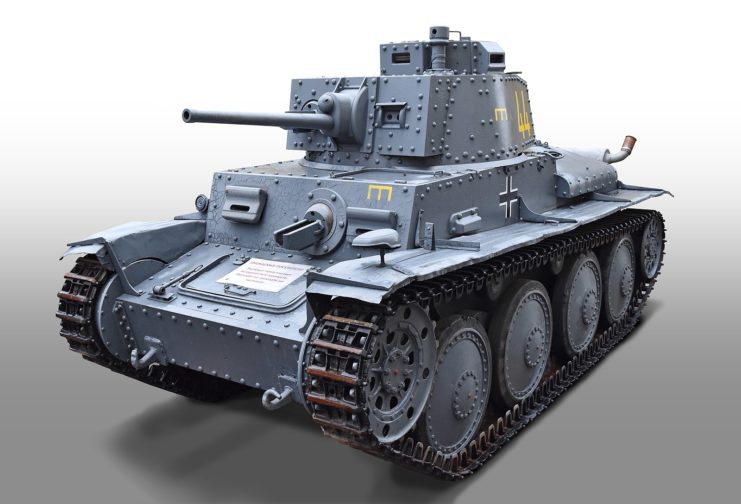
Development of the Panzer 38(t)
The tank that would eventually become the Czech Panzer 38t resulted from a competing arms interest that had developed in Czechoslovakia in the wake of the First World War. Czech arms companies Škoda and ČKD were in direct competition for Czechoslovakian Army contracts throughout the interwar years.
In 1935, Škoda Works and the ČKD jointly produced the Lehky tank vizor 35 (Light Tank Model 35, or LT-35). However, the LT-35 tank was both complex and had major shortcomings. The LT-35’s pneumatic steering and gear change systems tended to seize up in cold conditions, and the extensive use of rivets used in the hull’s construction caused major commotion in the crew compartment if the tank was hit by enemy fire.
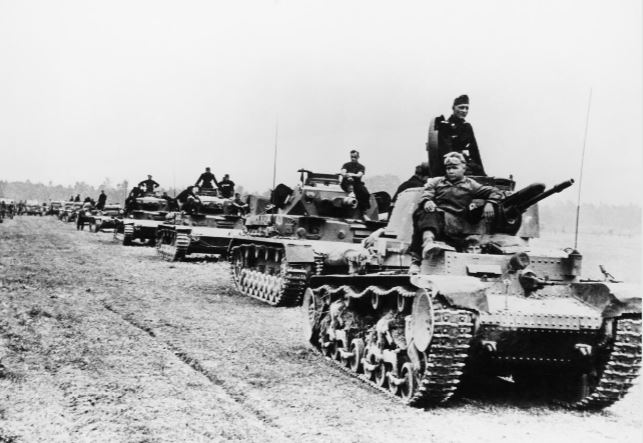
In October 1937, the Czechoslovak Ministry of Defence issued a specification for a replacement light tank. Already by this time, ČKD was working on a new line of armored vehicles. This new design adopted a Christie-type system (giving the tank more speed), with four large road wheels on each side of the tank, complete with layers of leaf springs for suspension. Steering was also improved by replacing the pneumatic system that was found in the LT-35. This TNH design was implemented on the AH-IV export tankette (classed as a light tank) and was exported to Iran, Peru, Switzerland, and Latvia.
In 1938, ČKD produced a modified version of the TNH for new Czechoslovakian specification, known as TNHPS. As a result, the Czechoslovakian government placed an order for 150 LT-38s, but in September 1938, when Czechoslovakia was forced to turn the Sudetenland over to Germany, most defense contracts were canceled.
German Invasion of Czechoslovakia
Before the onset of the Second World War, the German Army was actively engaged in expanding its new Panzer divisions. Consequently, great attention was given to the development of new types of tanks in Germany in the interwar years. However, due to stipulations laid out in the Treaty of Versailles and the lack of production capacity in Germany, the more desirable and stronger Panzer III and IV could not be produced in sufficient numbers. Instead, the German Army was forced to rely on their weakly armed Panzer I and Panzer II.
Luckily for the Germans and their Panzerwaffe, they came into possession of the Śkoda and the ČKD factories during the annexation of Czechoslovakia. In the Spring of 1939, the German Army integrated about 200 LT-35s into its light divisions. More importantly, however, was the acquiring of about 150 LT vz. 38s, although not all these tanks were completed during the German annexation. Both the LT-35 and LT-38 would be used in active service during the Second World War, but the Germans were primarily interested in the LT-38. The LT-38 was far superior to the Panzer I and Panzer II, as it closely resembled the larger Panzer III.
After the German invasion of Czechoslovakia, the LT vz. 38 increasingly was referred to as the Panzerkampfwagen 38(t), or alternatively Panzer 38(t). The letter T refers to the word “Tschechisch,” which is the German was for “Czech.” Ultimately, around 1400 Panzer 38(t)s were built after the German invasion of Czechoslovakia, and a number were sold to other Axis powers throughout the Second World War, including Hungary (who received 102 Panzer 38s), Slovakia (who received 69 Panzer 38s), Romania (who received 50 Panzer 38s), and Bulgaria (who received 10 Panzer 38s).
During its production, some minor changes were made to the Panzer 38(t), primarily adding thickness to its armor, as well as the addition of a German voice radio and intercom system. Overall, though, the Panzer 38(t)’s construction and design went relatively unchanged from its inception until the tank was discontinued in 1942. At the start of the Second World War, the 38(t) was a well-balanced vehicle with a solid tank gun, thick armor, and good maneuverability for the German army.
Throughout the Second World War, newer models of the Panzer 38(t) were introduced, designated by “Ausfürhung” (“model”) denominations ranging from A to S added to its name. Because these changes were just minor, classifying various models of the tank today is often very difficult.
Features of the Panzer 38(t)
Physically speaking, the Panzer 38(t) looked very similar to the Panzer 35(t), the main external difference being the four large road wheels on each side of the tank. It was also slightly shorter and lighter than the 35(t). The narrowness of the 38(t) was beneficial in it being able to effectively maneuver around, but ultimately, it would pose a major problem as it became impossible to mount larger guns in the turret.
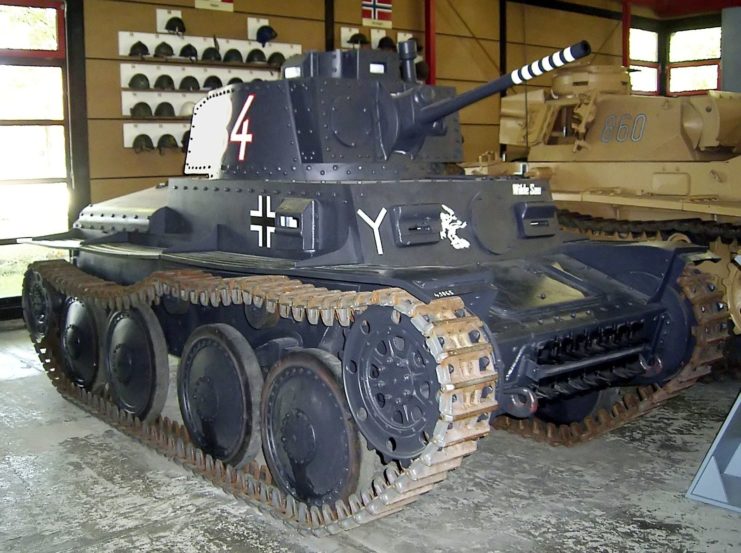
The turret was mounted centrally between the tracks, but slightly nearer to the front than the rear. It had a 37 mm A7 gun, which would prove to be adequate when confronting British and French light and medium tanks in short ranges. The Panzer 38(t) was also equipped with a machine gun in a ball mount. A second machine gun was mounted in the front of the superstructure.
The primary advantage of the Panzer 38(t) in comparison to other light tanks early in the Second World War was its high reliability and sustained mobility. In many cases, the crews of 38(t)s reported that the different components of the tank — including the engine, gear, steering, suspension, wheels, and tracks — were all perfectly in tune with one another. The Panzer 38(t) was also considered to be easy to maintain and repair.
Polish Campaign, 1939
In September 1939 at the time of the Invasion of Poland, the Panzer-Abteilung 67 (67th Tank Battalion) which was part of the Third Leichte Division (Light Division) had around 57 Panzer 38(t)s in their possession. Originally, the German army intended to equip the three companies that made up the 67th Tank Division all with 38(t)s, but there were not enough tanks to do so. This lack of 38(t)s meant that the 67th Tank Battalion was also equipped with Panzer II tanks.
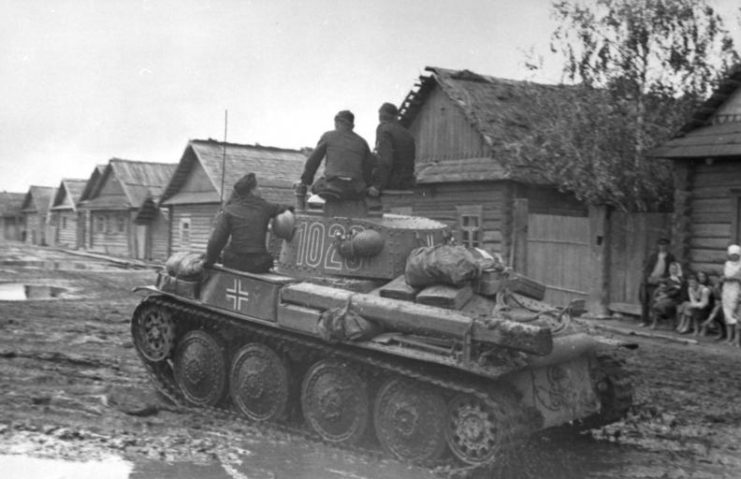
The first Panzer 38(t) was lost in battle on September 6, 1939, when it was hit by a Polish 3.7 cm anti-tank gun. Altogether, during the invasion of Poland, the Third Light Division lost only around seven Panzer 38(t)s, all of which were recovered, reassembled, and able to get back into action.
Generally speaking, the Panzer 38(t) performed well during the Polish Campaign. There were only minimal equipment and mechanical breakdowns during the campaign, but like other German tanks, the Panzer 38(t) lacked serious armor protection. Polish anti-tank guns were able to penetrate the Panzer 38(t)’s frontal armor up to a range of 300 meters away, and the anti-tank rifles at up to 100 meters away.
Battle of France, 1940
The French Campaign of 1940 saw the light tank divisions replaced by full-blown Panzer formations (the 6th, 7th, and 8th Panzer Divisions). During this campaign, a total of 228 Panzer 38(t)s saw active service — most of the Panzer 38(t)s being used with the 7th and 8th Panzer Divisions, while the 6th Panzer Division relied more on the Panzer 35(t).
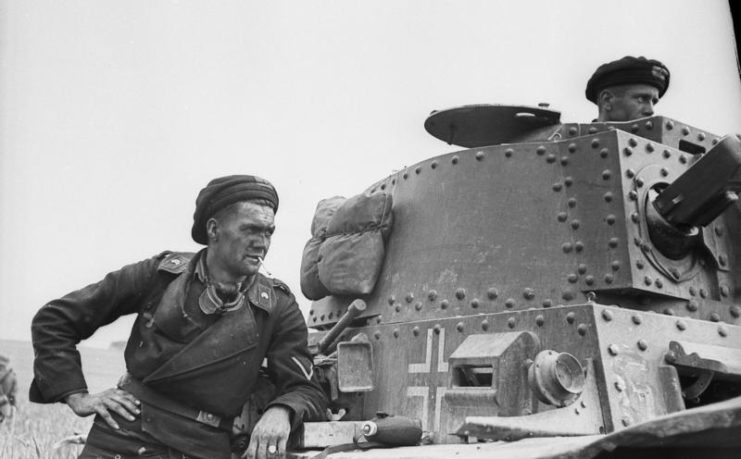
Both the 7th and 8th Panzer Divisions were involved in the main armored thrust that cut through French lines. The 7th Panzer Division, under the command of Erwin Rommel, was located on the right flank of the advance while the 8th Panzer Division was located in the center. French tanks, such as the Renault FT-17, the Hotchkiss H-39, and the Renault R-35 were no match for the Panzer 38(t). Even French medium tanks, including the Somua S-35, and heavy tanks including Char BI, were destroyed at the hands of expertly operated 38(t)s.
At the end of the French Campaign, the 38(t) was upgraded. In September 1940, the Panzer 38(t) Ausf. D entered into service, and in November 1940, the models E and F appeared. The 1940s upgrades included an increase in frontal armor and in the tank’s top speed.
Operation Barbarossa
By 1941, the status of the Panzer 38(t) was changing in the German Army. Although the later versions of the Panzer were better armored, the 37 mm guns on the tank largely remained the same throughout all the upgrades. By 1941, other German tanks, including the Panzer III and Panzer IV were gaining more powerful guns and pulling ahead of the Panzer 38(t) in terms of usefulness and reliability.
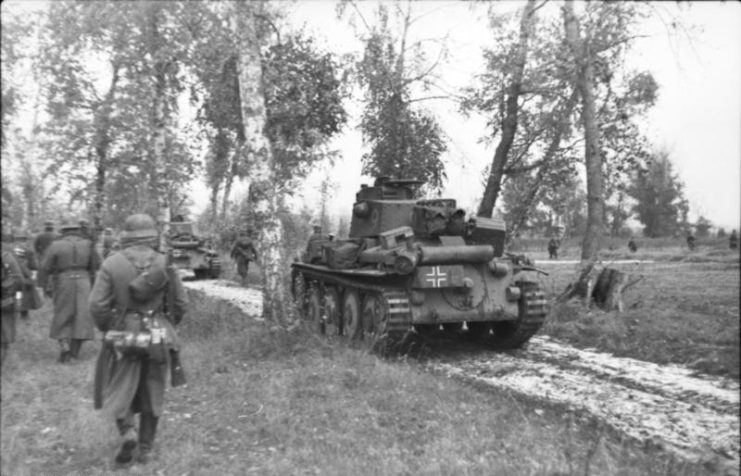
Nonetheless, the Panzer 38(t) was used in Operation Barbarossa, the German invasion of the Soviet Union in June 1941. Three more Panzer Divisions were equipped with the Panzer 38(t) besides the Divisions that had been used in the invasion of France.
Although the 38(t) had faired well in early conflicts of the Second World War, it was no match when pitted against Soviet tanks, especially the newer Soviet T-34 and KV series tanks. Heavy losses were reported in various Panzer Divisions during Operation Barbarossa. Gradually, the German Panzer Divisions began transitioning out the Panzer 38(t) for Panzer IIIs and IVs. In 1942, the Germans also sold 100 Panzer 38(t)s to their Hungarian allies.
The End of Panzer 38(t) Development
Along with the invasion of Poland, France, and the Soviet Union, the Panzer 38(t) saw action in Greece, the Balkans, and the Netherlands. However, by 1942, it was clear that the Panzer 38(t) was becoming increasingly obsolete. Production officially ended in 1942 after a total of 1,400 Panzer 38(t)s had been produced.
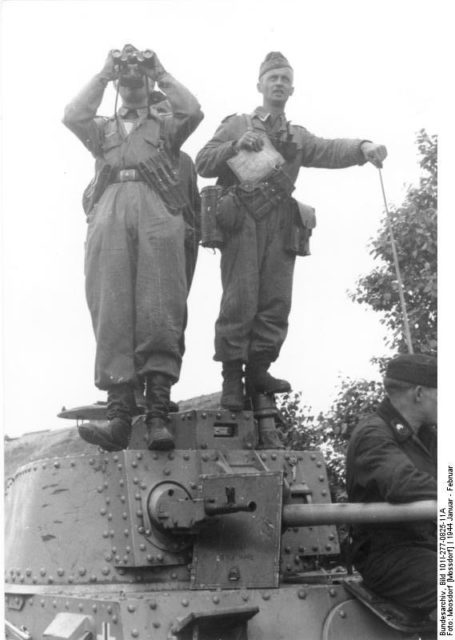
The Panzer 38(t) saw itself repurposed for other functions after its production had officially ended. The German Wehrmacht did supply their allies with weapons, including the Panzer 38(t).
More from us: Kugelpanzer: What Was The Purpose Of This German Armored Vehicle?
In March 1943, in an attempt to rearm their Romanian allies, the Germans gave some 50 Panzer 38(t)s to Romania. These tanks were then used by the Romanian Army to fight the Soviets but ultimately performed poorly against the Soviet forces.
Over 351 turrets from the Panzer 38(t) were used as stationary bunkers all around Europe during the Second World War. Although the Panzer 38(t) production was halted in 1942, the Czech-made weapon continued to serve a purpose throughout the entirety of the Second World War.
Post a Comment
0 Comments